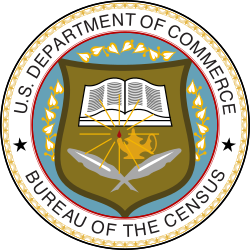| Nineteenth census of the United States | ||
|---|---|---|
| ||
 U.S. Census Bureau seal | ||
 1970 U.S. census logo | ||
| General information | ||
| Country | United States | |
| Results | ||
| Total population | 203,392,031 ( | |
| Most populous | California 19,953,134 | |
| Least populous | Alaska 302,173 | |
The 1970 United States census, conducted by the Census Bureau, determined the resident population of the United States to be 203,392,031, an increase of 13.4 percent over the 179,323,175 persons enumerated during the 1960 census.
Contents
- Data availability
- State rankings
- City rankings
- Locations of 50 most populous cities
- Conclusions
- Notes
- External links
This was the first census since 1820 in which New York was not the most populous state— California overtook it in population in January 1963. This was also the first census in which all states recorded a population of over 300,000, and the first in which a city in the geographic South— Houston —recorded a population of over 1 million.

Accurate racial census data was required by both the Civil Rights Act of 1964 and the Voting Rights Act of 1965, and the 1970 Census changed to identify race on the basis of self-identification rather than by government census enumerators. [1] Virtually all of the key items from the 1960 census were retained. [2]
